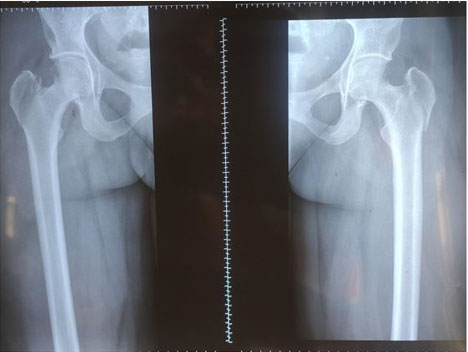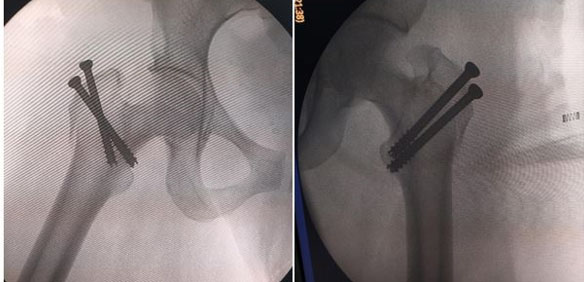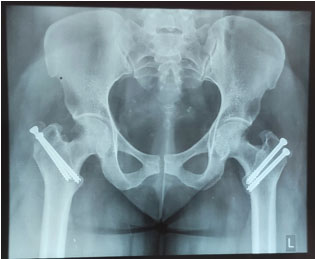 |
Case Report
Post-traumatic simultaneous bilateral greater trochanter fracture
1 Department of Orthopedics and Trauma, University College Hospital, Ibadan, Nigeria
Address correspondence to:
Emeka Collins Elumelu
Department of Orthopedics and Trauma, University College Hospital, Ibadan,
Nigeria
Message to Corresponding Author
Article ID: 100021O03TO2024
Access full text article on other devices

Access PDF of article on other devices

How to cite this article
Ogunrewo TO, Elumelu EC, Oladiran AB, Oyewole OA. Post-traumatic simultaneous bilateral greater trochanter fracture. Edorium J Orthop 2024;8(1):1–4.ABSTRACT
Introduction: Greater trochanter fractures could occur in isolation; the mechanisms range from direct trauma to avulsion type fractures; road traffic accidents have been implicated in etiology.
Case Report: A 28-year-old female store manager who was admitted to our facility via the emergency with simultaneous bilateral greater trochanter fracture following a motor vehicle accident. Plain radiograph revealed minimally displaced bilateral greater trochanter. The fractures were fixed percutaneously with canulated screws. The patient commenced ambulation two weeks postoperatively. She made full recovery and currently walking unaided ten months postoperatively.
Conclusion: The treatment of this type of injury is controversial because of its rarity as well as its etiology. There has been paucity of information of such injuries in the literature and its coverage in conventional textbooks limited. In our study we will discuss its etiology, mechanism of injury and management options.
Keywords: Bilateral fracture, Canulated screws, Greater trochanter, Simultaneous
INTRODUCTION
Greater trochanter fractures could either occur in isolation or with other fractures. It is more common in the young and active individuals. Males being more affected than females. Fractures involving the greater trochanter are of two distinctly different types. Epiphyseal separation seen in children and adolescents aged 7–17 years of age [1],[2],[3], with the mechanism of injury due to muscle contraction resulting in avulsion of the entire trochanteric apophysis while the second type results in comminuted greater trochanter fracture, usually seen in adults and caused by direct trauma.
Simultaneous bilateral greater trochanter fractures have been described as an extreme rarity and unusual, more so when it occurs in an adult.
We therefore report the case of a 28-year-old female with simultaneous bilateral greater trochanter fracture.
CASE REPORT
O.M., a 28-year-old female store manager was admitted via the emergency unit following injuries sustained in a pedestrian motor vehicle accident. She was hit on one side by the vehicle and landed on her other side, sustaining a laceration to forehead as well as difficulty with bearing weight on both lower limbs.
There was no loss of consciousness, no bleeding from craniofacial orifices, no seizures. Initial care was in a private hospital from where she was referred to our facility. Examination revealed a lady who is conscious. The vital signs at presentation showed a pulse of 86 beats per minute, respiratory rate of 24 cycles per minute, blood pressure of 110/70 mmHg, and a temperature of 37.4°C.
There was a sutured laceration on the forehead. The neck, chest, and abdomen showed normal findings.
The musculoskeletal system showed swelling, ecchymosis, and tenderness over the greater trochanter bilaterally. There was also tenderness over the left lateral malleolus.
Radiological investigation of the pelvis and the left leg showed fracture of the greater trochanter bilaterally (Figure 1). A diagnosis of closed fracture of the right and left greater trochanters fracture was made.
She subsequently had percutaneous canulated screw fixation of the bilateral greater trochanter fractures under image guidance (Figure 2). Intraoperative findings were minimally displaced bilateral greater trochanter fractures.
The patient recovered fully after surgery. Immediate postoperative period was uneventful, she commenced ambulation using Zimmer’s frame two-week’s post-surgery and was discharged to the outpatient clinic. The patient was last seen at the clinic walking unaided ten months postoperatively as seen in Figure 3.
DISCUSSION
Simultaneous bilateral greater trochanter fractures are uncommon [1],[2]. Epiphyseal fractures of children and adolescents are more common than the true fractures recorded in adults [2],[3],[4]. Fractures involving the greater trochanter of the femur can be caused either by direct trauma over the trochanter, in form of a blow, kick, or fall as well as by muscular violence [2],[3], in which the bony fragment is avulsed from the trochanter. Other causes of this fracture include osteoporosis and seizure disorder [5]. The etiology in this index patient is by direct trauma to one side of the pelvic region by a Nissan Micra car and landing on the other side (which is direct trauma) leading to an avulsion injury from its impact.
Bilateral hip fractures reported in the literature are almost entirely non-simultaneous as most occurred at different times. In these patients, fracture at one side is a risk for the contra lateral side [2]. Greater trochanter fracture occurs more in the male and young individuals; however, the index patient is a female and young.
Some patients with isolated fractures did not present immediately as the symptoms may not incapacitate them; however, this patient presented on the day of the injury in view of the bilateral nature and the severity of the pain felt as it affected her mobility.
Treatment of fractures of the greater trochanter is controversial [2],[3],[6]. Options of management that have been used in treating this condition include non-operative management by wide abduction in bed for a while to relax the powerful short abductors of the hip this is followed by exercises after the reduction of symptoms (about 2–3 weeks), open reduction and internal fixation with pins, pegs, and K-wires through a straight lateral incision on the greater trochanter. We chose operative fixation in this index patient because of its bilaterality and the age of the young patient. Percutaneous K wire fixation with insertion of canulated screws over it under image guidance was used to fix these fractures, the patient was able to start isometric exercises in bed, thereafter, and ambulatory exercises with Zimmer’s frame from the second week post-surgery. Expected full weight-bearing in 4–6 weeks post-surgery; achieved unaided by the 4th week. Last seen 10 months postoperatively, ambulating independently without complaints.
CONCLUSION
Bilateral fracture of the greater trochanter is a rare event, and it could be incapacitating. Different methods of management have been used to treat this condition. Screw fixation as used in this index patient provided a satisfactory outcome in this patient.
REFERENCES
1.
2.
Kambali M, Narayanpava V, Shantappa AH, et al. Simultaneous bilateral isolated greater trochanter fracture. J Orthop Allied Sci 2013;1(2):47–50. [CrossRef]

3.
Armstrong GE. XV. Isolated fractures of the greater trochanter. Ann Surg 1907;46(2):292–7. [CrossRef]
[Pubmed]

4.
Narouz I, Weerakkody Y, Niknejad M, et al. Isolated greater trochanteric fracture. Reference article, Radiopaedia.org. [Available at: https://radiopaedia.org/articles/57895]

5.
Akçali O, Koşay C, Günal I, Alici E. Bilateral trochanteric fractures of the femur in a patient with chronic renal failure. Int Orthop 2000;24(3):179–80. [CrossRef]
[Pubmed]

SUPPORTING INFORMATION
Author Contributions
TO Ogunrewo - Revising the work critically for important intellectual content, Final approval of the version to be published, Agree to be accountable for all aspects of the work in ensuring that questions related to the accuracy or integrity of any part of the work are appropriately investigated and resolved.
Emeka Collins Elumelu - Conception of the work, Design of the work, Acquisition of data, Drafting the work, Final approval of the version to be published, Agree to be accountable for all aspects of the work in ensuring that questions related to the accuracy or integrity of any part of the work are appropriately investigated and resolved.
AB Oladiran - Revising the work critically for important intellectual content, Final approval of the version to be published, Agree to be accountable for all aspects of the work in ensuring that questions related to the accuracy or integrity of any part of the work are appropriately investigated and resolved.
OA Oyewole - Revising the work critically for important intellectual content, Final approval of the version to be published, Agree to be accountable for all aspects of the work in ensuring that questions related to the accuracy or integrity of any part of the work are appropriately investigated and resolved.
Guaranter of SubmissionThe corresponding author is the guarantor of submission.
Source of SupportNone
Consent StatementWritten informed consent was obtained from the patient for publication of this article.
Data AvailabilityAll relevant data are within the paper and its Supporting Information files.
Conflict of InterestAuthors declare no conflict of interest.
Copyright© 2024 TO Ogunrewo et al. This article is distributed under the terms of Creative Commons Attribution License which permits unrestricted use, distribution and reproduction in any medium provided the original author(s) and original publisher are properly credited. Please see the copyright policy on the journal website for more information.








